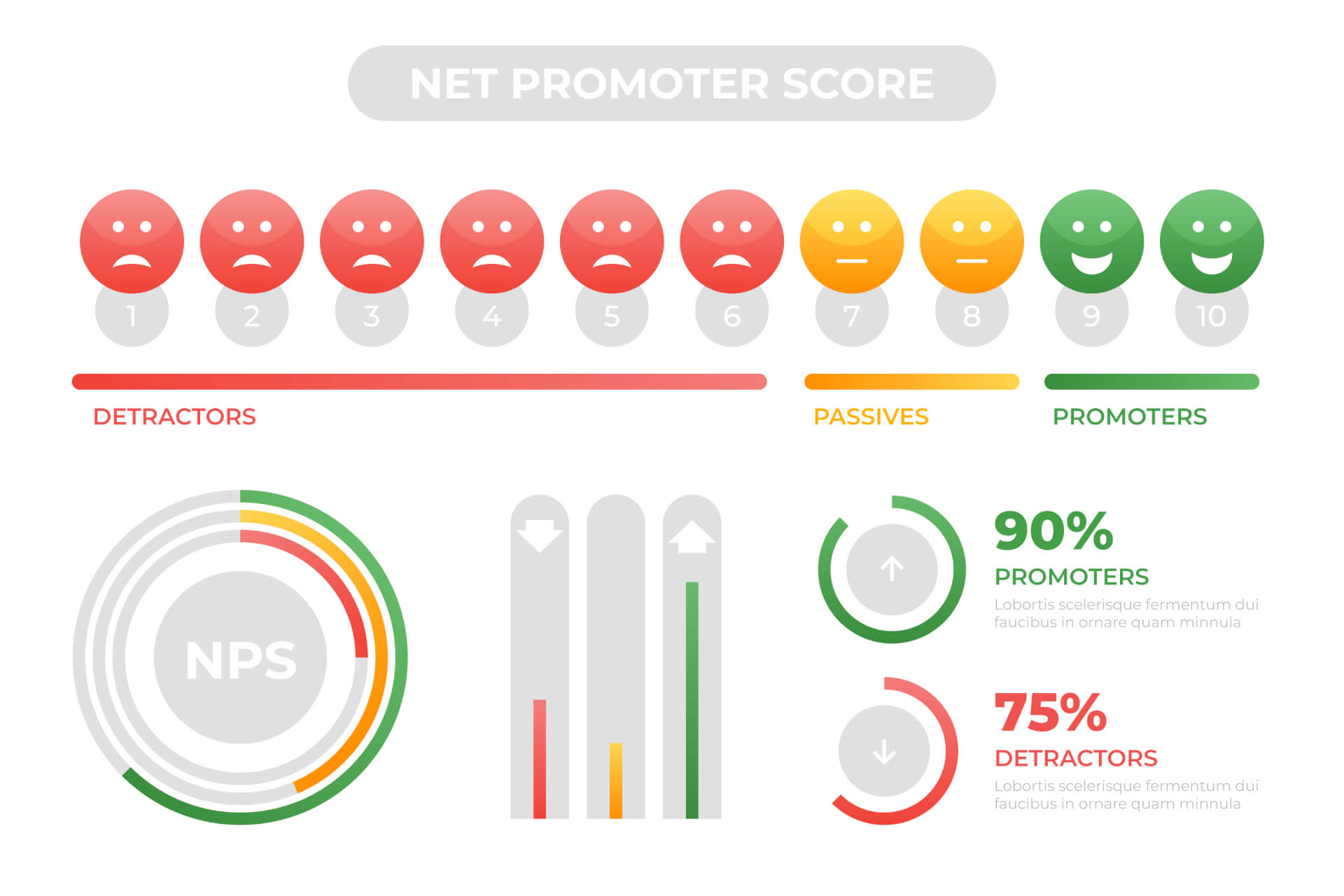WebWide Internet Communication GmbH, a Domain and Hosting provider , leverages the Net Promoter Score (NPS) to enhance its customer feedback processes.
NPS is a widely recognized metric that measures customer loyalty and satisfaction by asking a single question:
"On a scale of 0 to 10, how likely are you to recommend our company to a friend or colleague?"
This powerful tool helps businesses understand their customers better and drive improvements.

Table of Contents
- The Importance of Customer Feedback
- Understanding NPS (Net Promoter Score)
- About WebWide
- Implementing NPS
- Gathering Customer Feedback
- Analyzing NPS Data
- Taking Action on Feedback
- Benefits of Using Callexa NPS for Your Business
- Challenges and Solutions
- Real-Life Impact
- Expert Insights
- Comparative Analysis
- Best Practices for NPS Implementation
The Importance of Customer Feedback

Customer feedback is the cornerstone of any successful business. It provides insights into customer satisfaction, highlights areas for improvement, and fosters a culture of continuous enhancement.
By systematically collecting and analyzing feedback, companies can make informed decisions that lead to increased customer loyalty and better business outcomes.
Purpose of the Case Study
This case study aims to explore how WebWide uses NPS to gather actionable customer feedback, implement changes, and achieve measurable improvements.
It delves into the methodology, benefits, challenges, and real-life impacts of using NPS, providing a comprehensive guide for other businesses looking to adopt this powerful tool.
Understanding NPS (Net Promoter Score)
Definition of NPS
Net Promoter Score (NPS) is a customer loyalty metric that assesses how likely customers are to recommend a company's products or services to others. It categorizes respondents into three groups:
- Promoters (scores 9-10)
- Passives (scores 7-8)
- Detractors (scores 0-6).
The NPS is calculated by subtracting the percentage of Detractors from the percentage of Promoters.
How NPS Is Calculated
To calculate NPS, follow these steps:
- Distribute the NPS survey to your customers.
- Collect responses and categorize them into Promoters, Passives, and Detractors.
- Calculate the percentage of respondents in each category.
- Subtract the percentage of Detractors from the percentage of Promoters.
- For example, if 60% of respondents are Promoters and 20% are Detractors, the NPS would be 40.

History and Development of NPS
NPS was introduced by Fred Reichheld in 2003 through his work at Bain & Company. It was designed to be a simple yet effective way to measure customer loyalty and predict business growth.
Since its inception, NPS has become a standard metric used by companies worldwide to gauge customer satisfaction and drive improvements.
Importance of NPS in Business
NPS is crucial for businesses because it provides a clear, actionable measure of customer loyalty. High NPS scores are often associated with strong customer relationships, increased referrals, and sustainable growth. Conversely, low NPS scores highlight areas where the business needs to improve, providing a roadmap for enhancing the customer experience.
About WebWide
Company Background
WebWide Internet Communication GmbH is an expert in Domain and Webhosting services, specializing in services that businesses to be successfull with their online presence.
Founded with the mission to improve customer satisfaction, Callexa was implemented to make feedback collection and analysis seamless and effective.
Services Offered by Callexa
Callexa offers NPS surveys, that can be implemented at any point of the customer yourney to improve feedback analysis and customer engagement.
Callexa can be integrated smoothly with existing systems, providing businesses with the insights they need to enhance their customer experience strategies.
Callexa’s Mission and Vision
Callexa's mission is to empower businesses with the tools they need to understand their customers better and foster long-term loyalty. Our vision is to be the go-to platform for customer feedback, helping companies across industries achieve exceptional customer satisfaction and business success.
Implementing NPS

Initial Considerations and Planning
The first step was to outline clear objectives. The goal was to improve customer satisfaction, identify areas for enhancement, and foster stronger customer relationships.
Setting Up the NPS Survey
Setting up the NPS survey involved designing a simple, user-friendly questionnaire that could be easily distributed to customers. Callexa ensured that the survey was concise, focusing on the key NPS question and a few follow-up questions to gather additional insights.
Integrating NPS with Existing Systems
Integration was crucial for seamless feedback collection. Callexa offers a variety of integration options for the NPS survey since it´s first launch, enabling automatic survey distribution and response tracking. This integration ensured that all feedback can be managed centralized and provides easy access for analysis.
Gathering Customer Feedback

Methods of Collecting Feedback
Callexa provides multiple methods to collect feedback, including email surveys or website pop-ups. These varied methods ensured that users are able to reach a broad spectrum of customers, increasing the likelihood of obtaining comprehensive feedback.
Timing and Frequency of Surveys
The timing and frequency of surveys is of the outmost importance. With Callexa, it is possible to carefully plan sending surveys, to avoid survey fatigue while ensuring regular feedback collection.
Ensuring High Response Rates
To ensure high response rates, Callexa offers personalized survey invitations and keeps the surveys short and relevant. It is also possible to offer incentives, such as discounts or entries into prize draws, to encourage participation.
Analyzing Survey Responses
Analyzing survey responses is easy with the advanced analytics tools to identify patterns and trends. Callexa can segment responses by customer and other relevant factors to gain deeper insights into customer sentiment.
Analyzing NPS Data

Identifying Trends and Patterns
By analyzing NPS data, Callexa identified trends and patterns that provided WebWide with insights into customer satisfaction levels to pinpoint areas that need attention.
Segmenting Customers Based on Responses
Segmenting customers based on their NPS responses allowed WebWide to tailor their approach to different customer groups.
For example, it is possivble to focus on converting Passives into Promoters by addressing specific concerns raised by this group.
Interpreting NPS Scores
Interpreting NPS scores required understanding the broader context of customer feedback. WebWide compared the company scores against industry benchmarks and historical data to gauge the performance and identify areas for improvement.
Taking Action on Feedback

Developing Action Plans Based on Feedback
Based on the feedback collected, WebWide developed action plans aimed at addressing customer concerns and enhancing satisfaction. These plans included specific initiatives, targeted at improving productquality, enhancing customer service, and optimizing pricing strategies.
Each action plan was designed to be specific, measurable, achievable, relevant, and time-bound (SMART), ensuring clear objectives and accountability.
Implementing Changes in Products/Services
WebWide implemented changes based on the feedback received. For example, if customers expressed dissatisfaction with a particular product or feature, WebWide prioritized improving that feature in the next update.
Similarly, they enhanced customer service protocols based on common complaints, ensuring a better customer experience.
Communicating Changes to Customers
Transparency was key in WebWide's approach. They communicated the changes and improvements made in response to customer feedback through newsletters, email updates, and social media.
This not only demonstrated their commitment to customer satisfaction but also encouraged ongoing engagement and trust.
Monitoring the Impact of Changes
After implementing changes, WebWide closely monitored their impact using follow-up surveys and performance metrics. They tracked improvements in NPS scores, customer retention rates, and overall satisfaction to ensure that the changes had the desired effect.
Benefits of Using Callexa NPS for Your Business

Improved Customer Satisfaction
One of the most significant benefits of using NPS was the marked improvement in customer satisfaction.
By actively listening to and acting on customer feedback, WebWide was able to address issues promptly and effectively, leading to happier, more satisfied customers.
Increased Customer Loyalty
NPS helped WebWide identify and nurture loyal customers, turning satisfied customers into brand advocates. This increased customer loyalty translated into higher retention rates and more referrals, driving business growth.
Enhanced Brand Reputation
By demonstrating a commitment to customer satisfaction and continuous improvement, WebWide enhanced its brand reputation. Customers appreciated the company's responsiveness to feedback, which fostered a positive brand image and increased customer trust.
Better Understanding of Customer Needs
Using NPS allowed WebWide to gain a deeper understanding of their customers' needs and preferences. This insight enabled them to tailor their products and services more effectively, ensuring they met customer expectations and stayed ahead of competitors.
Challenges and Solutions

Common Challenges in Implementing NPS
Implementing NPS was not without its challenges. Common issues included low response rates, survey fatigue, and difficulty in interpreting feedback.
WebWide also faced challenges in integrating NPS data with existing systems and ensuring company-wide buy-in.
Solutions to Overcome These Challenges
To overcome these challenges, Callexa employed several strategies:
- Increasing Response Rates: They personalized survey invitations and offered incentives to encourage participation.
- Reducing Survey Fatigue: They kept surveys short and relevant, and avoided sending them too frequently.
- Improving Data Integration: They invested in robust software solutions that seamlessly integrated NPS data with their CRM systems.
- Ensuring Buy-In: They conducted extensive training and communicated the benefits of NPS to all employees, fostering a culture of customer-centricity.
Case Examples of Challenges Faced by WebWide
For instance, WebWide initially struggled with low response rates. By redesigning their survey invitations to be more engaging and offering small incentives, they saw a significant increase in participation.
Another challenge was interpreting open-ended feedback, which they addressed by using advanced text analysis tools to identify common themes and sentiments.
Real-Life Impact

Case Studies of Successful Feedback Implementation
Several case studies highlight the real-life impact of NPS. For example, after receiving feedback about long wait times for customer support, WebWide implemented a new support ticketing system. This change reduced wait times by 50%, leading to a significant increase in customer satisfaction scores.
Customer Testimonials
Customers have praised WebWide for their responsiveness to feedback. One customer noted,
"I appreciate how WebWide listens to our concerns and makes tangible improvements. It shows they really care about their customers."
Measurable Improvements in Key Performance Indicators
The impact of using NPS was evident in WebWide's key performance indicators. They saw a 20% increase in customer retention rates, a 15% rise in referral rates, and a noticeable improvement in overall customer satisfaction scores.
Expert Insights
Quotes from WebWide Executives
WebWide’s CEO stated,
"NPS has been a game-changer for us. It provides a clear, actionable metric that helps us stay aligned with our customers' needs and continuously improve our offerings."
Opinions from Industry Experts
Industry experts have also acknowledged the effectiveness of NPS. A renowned customer experience consultant noted,
"Callexa’s implementation of NPS is a textbook example of how businesses can leverage customer feedback to drive success."
Insights from NPS Professionals
NPS professionals emphasized the importance of regular feedback collection and prompt action. One expert commented,
"The key to NPS success is not just collecting feedback, but acting on it quickly and effectively. Callexa excels in this area."
Comparative Analysis
NPS vs Other Feedback Methods
Compared to other feedback methods like Customer Satisfaction Score (CSAT) and Customer Effort Score (CES), NPS offers a unique advantage by focusing on customer loyalty and long-term satisfaction. While CSAT measures immediate satisfaction and CES assesses the ease of customer interactions, NPS provides a broader view of customer loyalty.
Pros and Cons of NPS
Pros:
- Simple and easy to implement
- Provides clear, actionable insights
- Focuses on long-term customer loyalty
Cons:
- May not capture detailed feedback
- Can be influenced by external factors (e.g., market conditions)
- Requires follow-up to be effective
How to make your NPS Approach Stand Out
Show commitment to action. Don’t just collect feedback; act on it promptly and communicate changes to customers. This proactive approach leads to significant improvements in customer satisfaction and loyalty.
Best Practices for NPS Implementation
Tips for Successful NPS Surveys
- Keep surveys short and to the point.
- Personalize survey invitations to increase engagement.
- Offer incentives to encourage participation.
- Regularly review and update survey questions.
Avoiding Common Pitfalls
- Don’t send surveys too frequently to avoid fatigue.
- Ensure surveys are easy to complete on all devices.
- Follow up on feedback promptly to show customers their input is valued.
Conclusion

Summary of Key Points
WebWide’s use of NPS has significantly improved their customer feedback processes, leading to higher customer satisfaction and loyalty. By systematically collecting, analyzing, and acting on feedback, they have been able to make meaningful improvements and foster stronger customer relationships.
Importance of Continuous Feedback
Continuous feedback is essential for any business looking to stay competitive and meet customer needs. NPS provides a reliable, straightforward method for collecting this feedback and driving improvements.
Call to Action for Further Engagement
Businesses looking to enhance their customer feedback processes should consider implementing NPS. By following the best practices outlined here, companies can achieve similar success and improve their customer satisfaction and loyalty.
 Reading recommendation: If this article helped you and you would like to find out more about the Net Promoter Score, continue reading here: “The Net Promoter Score – Basics and Areas of Application”
Reading recommendation: If this article helped you and you would like to find out more about the Net Promoter Score, continue reading here: “The Net Promoter Score – Basics and Areas of Application”